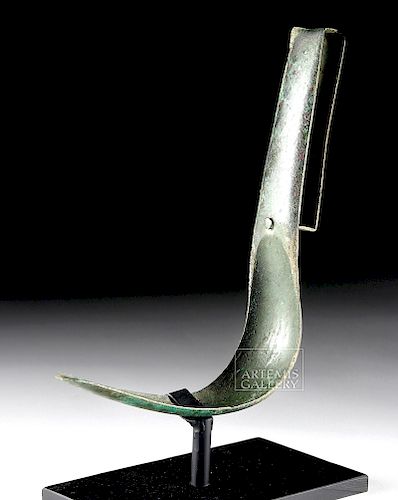Near-Choice Roman Bronze Strigil
Lot 81
About Seller
Artemis Gallery
686 S Taylor Ave, Ste 106
Louisville, CO 80027
United States
Selling antiquities, ancient and ethnographic art online since 1993, Artemis Gallery specializes in Classical Antiquities (Egyptian, Greek, Roman, Near Eastern), Asian, Pre-Columbian, African / Tribal / Oceanographic art. Our extensive inventory includes pottery, stone, metal, wood, glass and textil...Read more
Estimate:
$2,000 - $3,000
Absentee vs Live bid
Two ways to bid:
- Leave a max absentee bid and the platform will bid on your behalf up to your maximum bid during the live auction.
- Bid live during the auction and your bids will be submitted real-time to the auctioneer.
Bid Increments
| Price | Bid Increment |
|---|---|
| $0 | $25 |
| $300 | $50 |
| $1,000 | $100 |
| $2,000 | $250 |
| $5,000 | $500 |
| $10,000 | $1,000 |
| $20,000 | $2,500 |
| $50,000 | $5,000 |
| $100,000 | $10,000 |
| $200,000 | $20,000 |
About Auction
By Artemis Gallery
Feb 21, 2019
Set Reminder
2019-02-21 10:00:00
2019-02-21 10:00:00
America/New_York
Bidsquare
Bidsquare : Exceptional Antiquities, Asian, Ethnographic
https://www.bidsquare.com/auctions/artemis-gallery/exceptional-antiquities-asian-ethnographic-3858
An important one-day auction featuring museum-worthy examples of Egyptian, Greek, Roman, Etruscan, Near Eastern, Far East / Asian, Pre-Columbian, African / Tribal, Oceanic, Native American, Spanish Colonial, Russian, Fossils, Ancient Jewelry, Fine Art, so much more! Artemis Gallery info@artemisgallery.com
An important one-day auction featuring museum-worthy examples of Egyptian, Greek, Roman, Etruscan, Near Eastern, Far East / Asian, Pre-Columbian, African / Tribal, Oceanic, Native American, Spanish Colonial, Russian, Fossils, Ancient Jewelry, Fine Art, so much more! Artemis Gallery info@artemisgallery.com
- Lot Description
Roman, Imperial Period, ca. 1st to 3rd century CE. An elegant hammered bronze strigil created from a single sheet of bronze with a wide, concave, curved blade that tapers to a rounded end. The blade straightens out to a slender handle of a beautiful design as it bends back (with notches perhaps for inserting a string for suspension) and folds down dramatically along the verso to join the front side via a perforation. In the Classical World, athletes would apply olive oil to their bodies and scrape the skin's surface with a strigil to clean themselves. Demonstrating this, numerous ancient vase paintings depict athletes using strigils to cleanse themselves following exercise. A wonderful example of this ancient tool for athletes - covered in a marvelous patina of dark-green and russet-hues. Size: 9.5" W x 6.75" H (24.1 cm x 17.1 cm); 8.625" H (21.9 cm) on included custom stand.
The strigil was a scraper used in combination with olive oil and sand or pumice to exfoliate the skin after exercising or bathing. It was an essential piece of equipment for the typical Greek and Roman athlete, and as such came to symbolize athleticism itself. In addition to Greek vases with depictions of youthful athletes using strigils in the gymnasium, the celebrated sculpture by Lysippos, the Apoxyomenos (ca. 350 to 325 BCE) in the Vatican Museo Pio-Clementino, found in Trastevere, depicts a nude athlete scraping himself off with a strigil (http://www.museivaticani.va/content/museivaticani/en/collezioni/musei/museo-pio-clementino/vestibolo-quadrato-e-gabinetto-dell-apoxyomenos/apoxyomenos.html).
For a similar example, please see The Metropolitan Museum of Art, accession number 14.105.2: https://www.metmuseum.org/art/collection/search/248881
A similar example with an incised figure on the handle hammered for $9,000 at Sotheby's, New York Antiquities Auction (June 7, 2005, lot 2): http://www.sothebys.com/en/auctions/ecatalogue/2005/antiquities-n08104/lot.2.html
Provenance: private East Coast, USA collection; ex-Neil Phillips collection, New York, USA, acquired in the 1980s
All items legal to buy/sell under U.S. Statute covering cultural patrimony Code 2600, CHAPTER 14, and are guaranteed to be as described or your money back.
A Certificate of Authenticity will accompany all winning bids.
We ship worldwide and handle all shipping in-house for your convenience.
#143850Slight age wear as shown but intact and near choice. Surface has developed an attractive green and russet patina over the course of history.Condition
- Shipping Info
-
All shipping is handled in-house for your convenience. Your invoice from Artemis Gallery will include shipping calculation instructions. If in doubt, please inquire BEFORE bidding for estimated shipping costs for individual items.
-
- Buyer's Premium



 EUR
EUR CAD
CAD AUD
AUD GBP
GBP MXN
MXN HKD
HKD CNY
CNY MYR
MYR SEK
SEK SGD
SGD CHF
CHF THB
THB














